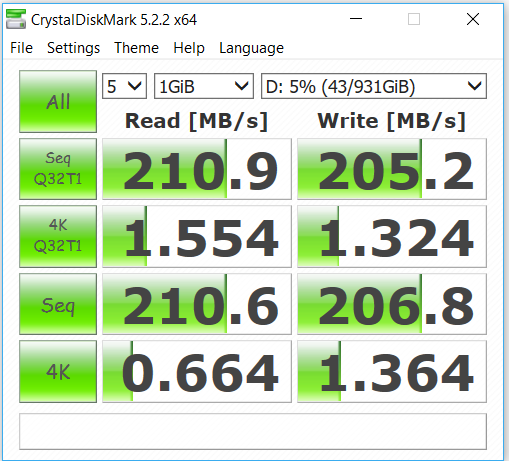Sometimes perceived performance gains can hit a wall because of one critical bottleneck. If you consider the progression from slow hard disks to SSDs attached to legacy disk channels to SSDs attached directly to PCIE you can see a perfect example of this. Consider the fastest hard drives; in this case the Seagate BarraCuda:

Sequential performance actually looks pretty decent. Random reads and writes, however, are a complete disaster. Not surprising given the nature of magnetic media. A physical disk head has to literally move across the spinning platter to find the right sector in a random read. Even given the most sophisticated engineering, physics becomes a limit. Now consider the fastest SATA SSDs; in this case the Samsung EVO 850:

This looks a lot better. Sequential more than doubles, but more importantly random reads are orders of magnitude better since now we’re talking about memory cell access where latencies are expressed in nanoseconds, not milliseconds. Astute reads will notice, however, that these sequential read are starting to bump right up against the theoretical maximum transfer rates of SATA (SATA 3 providing 6Gb/s with 8/10 encoding or 600MB/s of throughout). With the channel bandwidth a clear bottleneck, getting the SSD off the SATA channel and onto something faster was imperative; enter NVMe. Below is the Samsung EVO 960 that serves as bulk storage in the gaming beast and is riding the chipset lanes of the Z370 (hence bottlenecked potentially by 4GB/s DMI 3):

Sequential performance is now off the charts. That said, for most folks, NVMe doesn’t necessarily bring a game changing difference in terms of perceived performance for most users. Why? The 4K random performance holds the clue. Writes see a nice 2x increase, but reads are effectively even. And why does that matter? In a nutshell, small random read performance has always been the gatekeeper of perceived performance gain. That’s what’s behind the massive shift people perceive moving from HDD to SSD. The reason here is twofold. One is that small random read performance has been extremely slow both relative to sequential performance and in absolute terms basically forever. The other thing is that lots of tasks where disk performance is perceived (booting the OS, loading apps) are heavily dependent on loading a pile of small files. For comparison, here is the occupant of the other M.2 slot in the gaming beast, a Toshiba RD400 NVMe:

This part definitely lags the Samsung in a number of areas, but in the real world it feels functionally the same. For the reason why, look no further than the dead even small random.
With all of this backstory set, we have a new contender on the block! Intel Optane, made in conjunction with Micron, are SSD parts that do not utilize transistor based NAND memory, but instead utilize a new transistorless memory technology branded “3D XPoint“. The net result of the engineering wizardry in play here is that each memory cell in 3D XPoint can be directly addressed resulting in 1000x lower latency. The downside is this memory is hot, expensive and somewhat space inefficient in terms of packaging. Because of this, the first parts released took the form of a small cache (32GB) that slotted into the PCIE equipped M.2 slot on boards with Optane support. These parts were interesting, but not really game changing since the personal computing world has moved on from HDDs and the effect of cache on an SSD is less dramatic. This all changed last year with the release of the 900P which shipped in real world usable capacities (280GB, 480GB) for almost reasonable prices ($1.25/GB) in a PCIEx4 add in card. That meant they could be used as the OS boot drive. So what happens when you take a part with 1000x lower latency than an SSD and make it a boot drive? Yep, you guessed it:

Everything looks about the same right? Not so fast. Just look at that small random performance! A game changing 6x increase in 4K random reads, bringing the throughput to an unheard of 200MB+/s, brings a noticeable change to system boot. With an Optane 900P as the boot drive, system boot feels instantaneous. It isn’t an exaggeration to say that the BIOS POST takes an order of magnitude longer than the actual boot. Boot time for the OS off of Optane is now in the sub 2 second range. In a nutshell, it makes a monster gaming PC feel quicker to bring online than a console. That is an impressive update in an area where things had seemed to have hit a wall. It’s not cheap, and it isn’t quite on the level of the original jump from HDD to SSD, but Optane brings noticeable and significant improvement that is real world perceivable.
